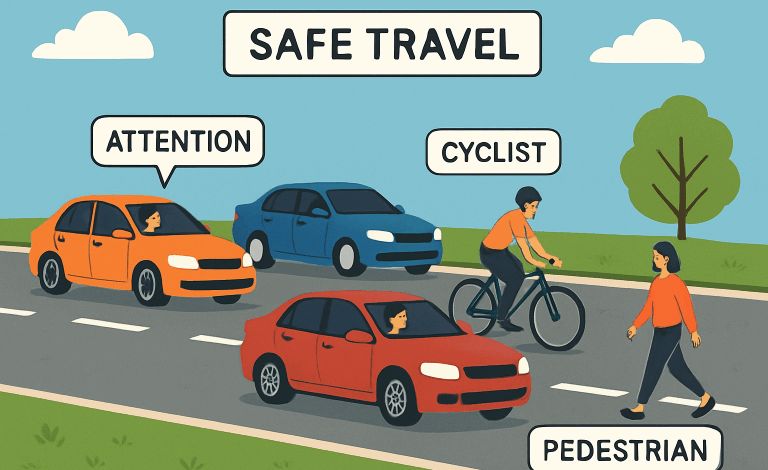
Drivers navigate a complex web of traffic, weather conditions, and unexpected hazards daily. The potential for accidents is ever-present, from crowded city streets to quiet rural roads. Even experienced drivers can encounter situations that test reaction times and decision-making, making awareness and caution essential. Understanding common road risks helps individuals take proactive measures, such as maintaining safe following distances, staying alert, and avoiding distractions.
While many factors can contribute to accidents, the most common cause of a collision is driver error, including distractions, misjudgments, or lapses in attention. Law firms like Wayne Hardee Law emphasize that even minor mistakes can have serious consequences. By recognizing these risks and practicing defensive driving, motorists can reduce the likelihood of accidents, protect themselves and others, and foster safer roads for everyone.
Main Causes Of Vehicle Collisions
Rapid advances in car safety and road design have significantly reduced certain risks, but the numbers suggest we still have a long way to go. Research consistently indicates that behavior at the wheel—rather than the vehicles themselves—continues to play the largest role in crash statistics. Driver distraction, excessive speed, intoxication, and reckless conduct account for most collisions. By comparison, hazardous weather conditions, infrastructure problems, and mechanical failures are responsible for a much smaller share of incidents.
Understanding the causes behind these tragedies is a vital first step in prevention.
Recognizing Risky Driving Behaviors
- Texting and Driving: Messaging behind the wheel combines manual, visual, and cognitive distractions, greatly increasing the likelihood of a crash.
- Speeding: Driving over the speed limit decreases reaction time and increases the impact of any collision, making injuries more severe.
- Impaired Driving: Whether under the influence of alcohol, prescription drugs, or recreational substances, impaired drivers have slower reflexes and poorer judgment.
- Aggressive Behaviors: Actions such as tailgating, frequent lane changes without signaling, and road rage heighten the risk for every road user.
Strategies To Stay Safer On The Road
Proactive driving is the best defense against collisions. Simple but consistent habits—like buckling up before putting the vehicle in gear—can distinguish between a close call and a tragedy. Prioritizing personal responsibility, drivers can follow these steps for safety:
- Always wear a seatbelt, and insist every passenger do the same—regardless of trip length or seating position.
- Eliminate distractions. Store your phone out of reach or use hands-free functionality only when strictly necessary.
- Respect speed limits at all times, and reduce speed in school zones, residential areas, or when visibility is compromised.
- Never drive while tired, emotional, or under the influence. If you’re not at your best, make alternate travel arrangements.
- Maintain a safe following distance. Give yourself room to react if another motorist makes a sudden maneuver.
The Role Of Technology And Smart Infrastructure
In recent years, there has been an explosion in vehicle technology that has been designed to mitigate human error. Features such as lane-keeping assistance, blind spot warnings, and automatic emergency braking have become standard on newer models. Beyond cars themselves, urban planners are investing in smart infrastructure: traffic-calming roundabouts, better signage, and adaptive traffic signals that adjust to congestion in real time. The positive outcomes are clear—cities incorporating these elements often report a marked decline in injury rates.
However, while technology provides extra layers of protection, it doesn’t replace the need for focused driving. Over-reliance on automated systems can sometimes lead to complacency. No matter how advanced the safety features, an attentive and responsible driver remains the most valuable safety component.
Community Initiatives And Education
Tangibly improving road safety takes more than just personal change or new gadgets: it requires community action. Across North America and worldwide, city governments, schools, and nonprofits are investing in comprehensive education campaigns. Defensive driving programs, anti-distracted driving advertisements, and helmet-promotion initiatives help change the culture around road safety. Collaborative projects like Vision Zero pursue the ambitious goal of eliminating crash fatalities through policy shifts, enforcement efforts, and broad-based public awareness—all proven to save lives.
What To Do After A Collision
Even the safest drivers can experience a collision due to the unpredictable nature of the road. In a crash, start by ensuring your safety and that of everyone involved. If vehicles can be moved, steer them out of traffic’s way. Always check for injuries and call emergency services if anyone is hurt—or if there’s significant property damage. Exchange contact and insurance details with all involved parties, document the scene with photographs, and seek witness information if possible. Cooperating with law enforcement and your insurance company can simplify the aftermath and ensure fair accountability.
Conclusion: Working Together For Safer Roads
Significant improvements in road safety result from collective efforts across all levels: policymakers, vehicle makers, city officials, and pedestrians. Recognizing that human error is the leading cause of accidents allows everyone to minimize risks through safer habits, advocating for good policies, and engaging constructively within the community. Whether driving, cycling, or walking, making well-informed decisions plays a crucial role in ensuring the safety of all.


